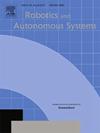基于模型预测控制的动态运动原语的轨迹学习和避障
IF 5.2
2区 计算机科学
Q1 AUTOMATION & CONTROL SYSTEMS
引用次数: 0
摘要
动态运动原语(Dynamic Movement Primitives, DMP)是一个成熟的从演示中学习的框架,广泛用于获取和复制运动模式。为了提高DMP在复杂环境中的适应性和泛化能力,提出了一种基于模型预测控制的DMP避障方法。该方法在MPC框架内形式化DMP,并采用最优控制解算器的邻均牛顿法将避障条件纳入成本函数,适应各种环境,提高了避障效率。在二维和三维空间的静态和动态障碍以及多障碍和动态环境中进行了评估。它适应了DMP的缩放特性,在复杂场景下表现出鲁棒性。此外,安全阈值的加入增强了该方法的鲁棒性,确保了在不确定环境下的安全避障。与人工势场方法和转向角方法的定量比较,突出了它们在轨迹效率和避障成功率方面的优越性。最后,通过仿真和现实世界的实验验证,包括UR5机器人的拾取和放置任务,证明了该方法在机器人操作中的实际适用性。本文章由计算机程序翻译,如有差异,请以英文原文为准。
Model Predictive Control-based dynamic movement primitives for trajectory learning and obstacle avoidance
Dynamic Movement Primitives (DMP) is a well-established framework in Learning from Demonstration, widely used for acquiring and reproducing motion patterns. To improve DMP’s adaptability and generalization in complex environment, this paper introduces a novel DMP obstacle avoidance approach by integrating Model Predictive Control (MPC). The proposed method formalizes DMP within an MPC framework and employs the Proximal Averaged Newton for Optimal Control solver to incorporate obstacle avoidance conditions into the cost function, adapting to various environments and improving obstacle avoidance efficiency. Evaluations were conducted in scenarios involving static and dynamic obstacles across two- and three-dimensional spaces, as well as multi-obstacle and dynamic environments. It adapts to the scaling characteristics of DMP, demonstrating robustness in complex scenarios. Additionally, the inclusion of a safety threshold enhances the method’s robustness, ensuring safe obstacle avoidance in uncertain environments. Quantitative comparisons with Artificial Potential Field and Steering Angle approaches highlight superior performance in trajectory efficiency and obstacle avoidance success. Finally, validation through simulations and real-world experiments, including a pick-and-place task on UR5 robot, demonstrate the approach’s practical applicability in robotic operations.
求助全文
通过发布文献求助,成功后即可免费获取论文全文。
去求助
来源期刊

Robotics and Autonomous Systems
工程技术-机器人学
CiteScore
9.00
自引率
7.00%
发文量
164
审稿时长
4.5 months
期刊介绍:
Robotics and Autonomous Systems will carry articles describing fundamental developments in the field of robotics, with special emphasis on autonomous systems. An important goal of this journal is to extend the state of the art in both symbolic and sensory based robot control and learning in the context of autonomous systems.
Robotics and Autonomous Systems will carry articles on the theoretical, computational and experimental aspects of autonomous systems, or modules of such systems.
 求助内容:
求助内容: 应助结果提醒方式:
应助结果提醒方式:


